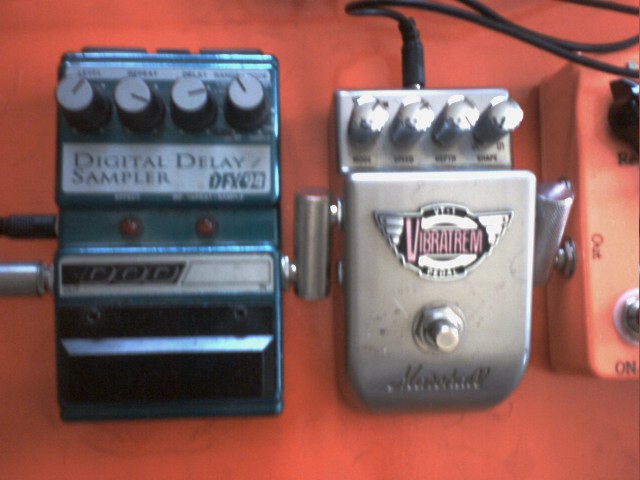Mar 19 2006
Guitar Effects
The signal chain for my performance was:
The Gretsch BST-1500 and/or the Industrial Guitar Indy Rail > Ernie Ball VP Jr Volume Pedal > HBE UFO (fuzz/octave) > Analog Man Sun Face (NKT275 with Sun Dial mod) (fuzz) > HBE Psilocybe (phaser) > Marshall Vibrotrem > DOD DFX94 Digital Delay/Sampler > Line6 Delay Modeler > Fender Blues Jr. Amplifier.
I also used a cheap digital voice recorder, purchased in Little India, that I played by holding it against the pickup of the lapsteel. You can hear this about 5 minutes in. Later, I also use an Ebow to create long sustained notes. You can hear this toward the end, around 9 minutes or so.
The set of guitar effects I use is designed to provide me with a wide sonic pallet. Each one adds to or changes the sound in a distinctive way. I sometimes use them by themselves, or in combination with other pedals. With the 7 pedals, there are countless variations possible.
First in the signal chain is an Ernie Ball VP Jr. This volume pedal serves two functions. One is to cut the sound from the guitar to the system if, for example, I have to tune or change instruments. The other is to do ‘swells’, where I pluck a note then, with my foot, bring the note in, making it sound more like a violin.
The first effect in the signal chain is the HomeBrew Electronics UFO, or Ultimate Fuzz Octive. This hand-built, custom painted pedal is super-clean, has tons of gain, and two flavors of fuzz. The Octave circuit gives high notes a piercing tonality. This feeds into the Analog Man Sunface NKT275 Fuzz with New Old Stock Germanium transistors. This hand built pedal creates what sounds to me like the classic vintage fuzz tone. The builder insists that only non-alkaline cheapo batteries should be used. I’ve tried both, and even a power supply, but the cheap batteries sound the best.

The Fuzz pedals create a kind of distortion I associate with the psychedelic 60’s. Robert Fripp of King Crimson fame is someone I try to emulate, but many famous guitarists used fuzz, including hendrix… Think of the lead guitar in Incents & Peppermints.
The first Fuzz has a brighter, edgier tone to it. The 2nd has a warmer, richer tone. When both are on, I can make the notes I play sustain for ages.
Next up, the HBE Psilocybe, a hand built, custom painted Phase Shifter. I have #7. BTW, I love phase shifting. The effect is both subtle and sweet. This one has a soft touch.

The Phaser is also an effect that was made popular in the 60s. It adds a subtle, ever changing, ‘swirl’ to the sound. (Also, in my mind, very psychedelic) Billy Joel uses a phaser on his electric piano on “Just The Way You Are.”
Next in the signal chain is the Marshall Vibrotrem. This is an amplitude modulation effect. (Imagine turning the volume up and down really quickly.) I use it sparingly, but it adds a certain intensity that, sometimes, is required. The Vibrotrem feeds into a DOD Digital Delay/Sampler, which I use as a kind of Pre-Delay for my Line6. I’ll set up a shorter delay, perhaps 1 second, and set the line6 delay at some multiple of it.

The Vibrotrem is a classic effect that you’ve probably heard on tons of records. If you know the classic song “What Condition My Condition Was In” by The First Edition, you can hear both Fuzz and tremolo on the electric guitar. I believe this effect was designed to emulate the Leslie Rotating Speaker, used by organists. If you listen to the “yeah yeah yeah” background vocals, they’re being run through a Leslie Rotating Speaker.
Because the Leslie Rotating Speaker is, well, rotating, when you place a stationary microphone next to it, there is a subtle Dopler effect. The pitch of the note is raised slightly as the speaker approaches the microphone, and drops slightly once it passes. This combination of pitch and amplitude modulation gives the Leslie a very specific sound. My pedal does not reproduce the pitch modulation, just the amplitude modulation.
Last in line is the Line6 Delay Modeler. This has a setting that allows very long delays, upward of 20 seconds. I usually use delays of 5 or 6 seconds, but sometimes longer…. I love this pedal. It has headroom to die for.

The delays repeat everything I play at a specific interval, allowing me to add notes on top of, before, or after notes I’ve already played. As they repeat, the notes I’ve played slowly fade.
BTW, If you can, listen to
Not pictured are my Ernie Ball VP Jr Volume Pedal, which I put at the front of the signal chain, and my Fender Blues Jr. amplifier, which I absolutely love. For a low power amp, it gets pretty darn loud, but has a wonderful all-tube clarity.
Peace.
[…] If you’re interested, you can see pix of the guitar effects I use and read about what they do. Enjoy! […]
[…] My performance was a form of “Frippertronics,” a systems based compositional/improvisational methodology developed by Brian Eno and Robert Fripp. The system is very simple: everything I play (on this particular evening I was using Electric Guitar and Lap Steel) repeats and slowly fades out. One can add notes before, after, or on top of previously played notes to create harmonic or melodic movement, producing an ever evolving sound. I use a number of effects to alter the sound of my instruments, including two Fuzz pedals, a Phaser, a Tremelo, and another delay. […]
Your article is very informative. I was wondering have you ever heard of any guitar effect that could make a electric six string guitar sound an steel guitar. I would sure like to know if this is possible.
Thanks for you help.
Ed